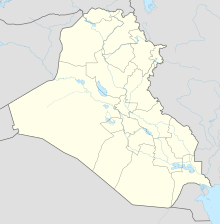| Battle of Saddam City | |||||||
|---|---|---|---|---|---|---|---|
| Part of the 1991 uprisings in Iraq | |||||||
| |||||||
| Belligerents | |||||||
|
|
| ||||||
| Commanders and leaders | |||||||
|
| Unknown | ||||||
| Units involved | |||||||
| Republican Guard | Unknown | ||||||
| Strength | |||||||
| 7,000 soldiers | Unknown | ||||||
 | |||||||
| 1991 Iraqi uprisings | |
|---|---|
| Southern Iraq Northern Iraq/Kurdistan Region |
The Battle of Saddam City occurred in March 1991 as part of the wider anti-Saddam uprisings across Iraq, although the uprising in the Saddam City district of Baghdad was far more limited in scale than the kind of uprisings seen in southern Iraq. In response to the unrest in Saddam City, Saddam Hussein's son Qusay Hussein led a siege of the district, with dissent being repressed. Baghdad as a whole remained quiet, with the capital serving not as a center for the uprisings, but as a staging post for the government counter-offensive.
The Saddam City unrest
Whilst the uprisings saw the Iraqi Government lose control over 14 of Iraq's 18 provinces in March 1991, Baghdad remained largely passive. This was in part due to the fact that the Dawa Party, the Communist Party, and the pro-Syrian Ba'ath splinter party had all failed to build underground structures in the capital. Instead, the unrest within Baghdad was limited to the vast suburban Shia-populated slum of Saddam City, which by 1991 had a population of 1 million, and which was a stronghold of Shiite cleric Mohammad Mohammad Sadeq al-Sadr.
Baghdad also saw more limited unrest due to the fact that strict government control over the media and communication prevented the full scale of the Iraqi defeat in the Gulf War from being apparent to the residents of Baghdad, who, unlike the residents of southern Iraq, had not witnessed the Iraqi defeat unravel on their doorstep. Whilst many parts of the country also saw some degree of a power vacuum, the Iraqi government maintained a large security presence within Baghdad.
In response to the uprising Qusay Hussein led a government siege of the district. Some 7,000 troops were transferred to Baghdad on 4 March in order to augment the city's defenses, and the Iraqi Government would declare a state of emergency in Baghdad on 21 March.
Aftermath
Following the uprising, Saddam stationed an elite Special Republican Guard battalion (the 10th Battalion) at the al-Rashid barracks near Saddam City. The battalion was charged with sealing off and indiscriminately bombarding the district in the case of future revolts, in a manner similar to the Republican Guard actions in Najaf and Karbala.
References
- "FRONTLINE/WORLD . Iraq - Saddam's Road to Hell - A journey into the killing fields . PBS". pbs.org. Retrieved 18 February 2016.
- "Why the Uprisings Failed | Middle East Research and Information Project". Merip.org. 4 May 1992. Retrieved 14 August 2013.
- ^ Thabit Abdullah (2006). Dictatorship, Imperialism and Chaos: Iraq Since 1989. Zed Books. p. 82. ISBN 978-1-84277-787-9.
- Nimrod Raphaeli (September 2004). "Understanding Muqtada al-Sadr". Middle East Forum. Retrieved 18 February 2016.
- Fanar Haddad (2014). Sectarianism in Iraq: Antagonistic Visions of Unity. Oxford University Press. p. 295. ISBN 978-0-19-023797-4.
- David E. Johnson; M. Wade Markel; Brian Shannon (2013). The 2008 Battle of Sadr City: Reimagining Urban Combat. Rand Corporation. p. 116. ISBN 978-0-8330-8028-8.
- "MAR | Data | Chronology for Shi'is in Iraq". Archived from the original on 3 March 2016. Retrieved 18 February 2016.
- Baram, Amatzia (June 1998). "Between Impediment and Advantage: Saddam's Irag" (PDF). United States Institute of Peace. p. 6. Retrieved 20 June 2023.
External links
Categories:- 1990s sieges
- 1991 Iraqi uprisings
- 20th-century mass murder in Iraq
- Collective punishment
- Sieges of Baghdad
- 1990s in Baghdad
- Mass murder in 1991
- Mass murder in Baghdad
- Iraqi war crimes
- Violence against Shia Muslims in Iraq
- War crimes in Iraq
- Sadr City
- March 1991 events in Iraq
- 1991 murders in Iraq
- 1991 building bombings
- Building bombings in Baghdad